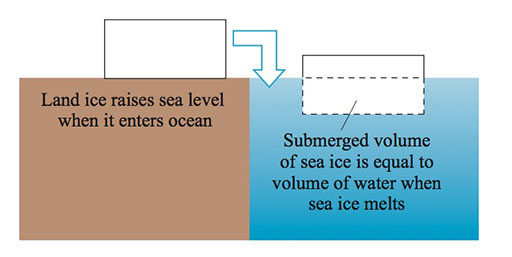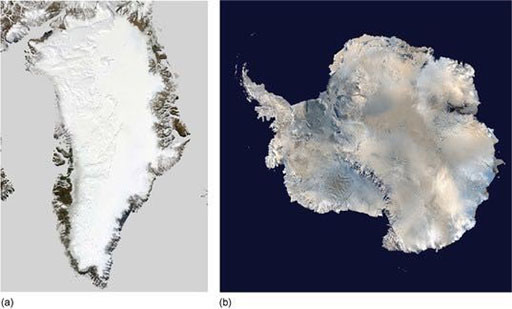3.2 Ice sheets
Activity 3 Global sea level rise
a.
land ice (ice sheets and glaciers resting on land)
b.
sea ice (ice floating in the oceans)
c.
neither land ice nor sea ice
d.
both land ice and sea ice
The correct answer is a.
Discussion
Only the melting of land ice changes global sea levels: melting sea ice does not change sea level.
When ice on the land melts and flows into the seas, this raises sea levels because it adds a new volume of water to the ocean (Figure 8).
Ice is less dense than water, which is why it floats. When floating ice melts, it forms a smaller volume of water than the original volume of ice. In fact, the volume of water formed is exactly the same as the volume of ice that was below the water surface when it was floating, so no change in sea level occurs.

The glaciers and great ice sheets of Greenland and Antarctica (Figure 9) might seem like giant ice cubes, inert but for gradual melting from climate change. In fact, they are dynamic, shifting landscapes, places of delicate balance between the forces that create ice and those that destroy it.
Under its own immense weight, ice flows continuously downwards, towards the sea if possible. Ice is lost whenever icebergs break off into the sea – along ice sheet coasts – or whenever the surface is warm enough to melt it. Ice is constantly replaced as falling snow compacts, or rain and meltwater freeze. It all adds up to an ice ‘mass budget’ that changes with altitude, location, the seasons and long-term climate change.
This dynamic nature of ice means that dramatic images of the end of a glacier collapsing, or a huge iceberg breaking away, are not necessarily caused by climate change. Likewise, these events may not be causing global sea level rise, because glaciers are constantly losing and gaining ice. What matters for climate change and global sea level rise is how fast ice is being lost, and whether the rate of loss is increasing.
Read the following statements and answer the question below:
- The Greenland ice sheet has lost around 34 billion tonnes of ice per year over the period 1971–2009, and around 215 billion tonnes per year from 2002–2011.
- The Antarctic ice sheet has lost around 30 billion tonnes of ice per year over the period 1992–2001, and around 147 billion tonnes per year from 2002–2011.
- Glaciers around the world have lost around 226 billion tonnes of ice per year over the period 1971–2009, and around 275 billion tonnes per year from 1993–2009 (IPCC, 2013).
-
For which of these three sources of land ice have ice losses sped up the most?
-
The Greenland ice sheet: the rate has increased by around six times.
A loss of 360 billion tonnes of land ice is equivalent to about 1 mm of global mean sea level rise. This may seem a small amount, but this is happening every year, and the rate of loss is not constant.

